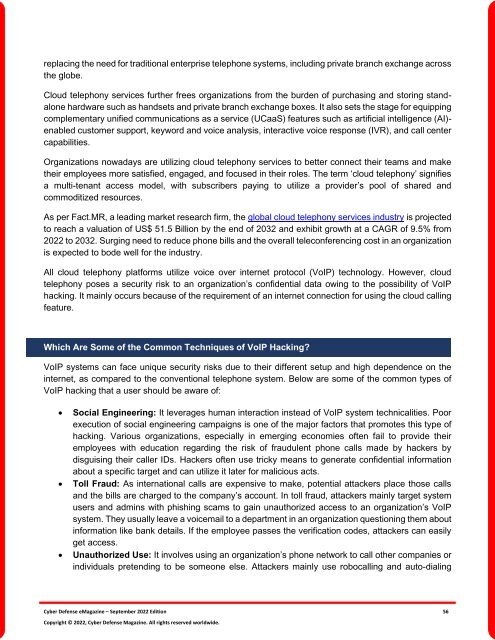Cyber Defense eMagazine September Edition for 2022 #CDM
#CYBERDEFENSEMAG @CyberDefenseMag by @Miliefsky a world-renowned cyber security expert and the Publisher of Cyber Defense Magazine as part of the Cyber Defense Media Group as well as Yan Ross, Editor-in-Chief and many more writers, partners and supporters who make this an awesome publication! Thank you all and to our readers! OSINT ROCKS! #CDM #CDMG #OSINT #CYBERSECURITY #INFOSEC #BEST #PRACTICES #TIPS #TECHNIQUES
#CYBERDEFENSEMAG @CyberDefenseMag by @Miliefsky a world-renowned cyber security expert and the Publisher of Cyber Defense Magazine as part of the Cyber Defense Media Group as well as Yan Ross, Editor-in-Chief and many more writers, partners and supporters who make this an awesome publication! Thank you all and to our readers! OSINT ROCKS! #CDM #CDMG #OSINT #CYBERSECURITY #INFOSEC #BEST #PRACTICES #TIPS #TECHNIQUES
You also want an ePaper? Increase the reach of your titles
YUMPU automatically turns print PDFs into web optimized ePapers that Google loves.
eplacing the need <strong>for</strong> traditional enterprise telephone systems, including private branch exchange across<br />
the globe.<br />
Cloud telephony services further frees organizations from the burden of purchasing and storing standalone<br />
hardware such as handsets and private branch exchange boxes. It also sets the stage <strong>for</strong> equipping<br />
complementary unified communications as a service (UCaaS) features such as artificial intelligence (AI)-<br />
enabled customer support, keyword and voice analysis, interactive voice response (IVR), and call center<br />
capabilities.<br />
Organizations nowadays are utilizing cloud telephony services to better connect their teams and make<br />
their employees more satisfied, engaged, and focused in their roles. The term ‘cloud telephony’ signifies<br />
a multi-tenant access model, with subscribers paying to utilize a provider’s pool of shared and<br />
commoditized resources.<br />
As per Fact.MR, a leading market research firm, the global cloud telephony services industry is projected<br />
to reach a valuation of US$ 51.5 Billion by the end of 2032 and exhibit growth at a CAGR of 9.5% from<br />
<strong>2022</strong> to 2032. Surging need to reduce phone bills and the overall teleconferencing cost in an organization<br />
is expected to bode well <strong>for</strong> the industry.<br />
All cloud telephony plat<strong>for</strong>ms utilize voice over internet protocol (VoIP) technology. However, cloud<br />
telephony poses a security risk to an organization’s confidential data owing to the possibility of VoIP<br />
hacking. It mainly occurs because of the requirement of an internet connection <strong>for</strong> using the cloud calling<br />
feature.<br />
Which Are Some of the Common Techniques of VoIP Hacking?<br />
VoIP systems can face unique security risks due to their different setup and high dependence on the<br />
internet, as compared to the conventional telephone system. Below are some of the common types of<br />
VoIP hacking that a user should be aware of:<br />
• Social Engineering: It leverages human interaction instead of VoIP system technicalities. Poor<br />
execution of social engineering campaigns is one of the major factors that promotes this type of<br />
hacking. Various organizations, especially in emerging economies often fail to provide their<br />
employees with education regarding the risk of fraudulent phone calls made by hackers by<br />
disguising their caller IDs. Hackers often use tricky means to generate confidential in<strong>for</strong>mation<br />
about a specific target and can utilize it later <strong>for</strong> malicious acts.<br />
• Toll Fraud: As international calls are expensive to make, potential attackers place those calls<br />
and the bills are charged to the company’s account. In toll fraud, attackers mainly target system<br />
users and admins with phishing scams to gain unauthorized access to an organization’s VoIP<br />
system. They usually leave a voicemail to a department in an organization questioning them about<br />
in<strong>for</strong>mation like bank details. If the employee passes the verification codes, attackers can easily<br />
get access.<br />
• Unauthorized Use: It involves using an organization’s phone network to call other companies or<br />
individuals pretending to be someone else. Attackers mainly use robocalling and auto-dialing<br />
<strong>Cyber</strong> <strong>Defense</strong> <strong>eMagazine</strong> – <strong>September</strong> <strong>2022</strong> <strong>Edition</strong> 56<br />
Copyright © <strong>2022</strong>, <strong>Cyber</strong> <strong>Defense</strong> Magazine. All rights reserved worldwide.


















